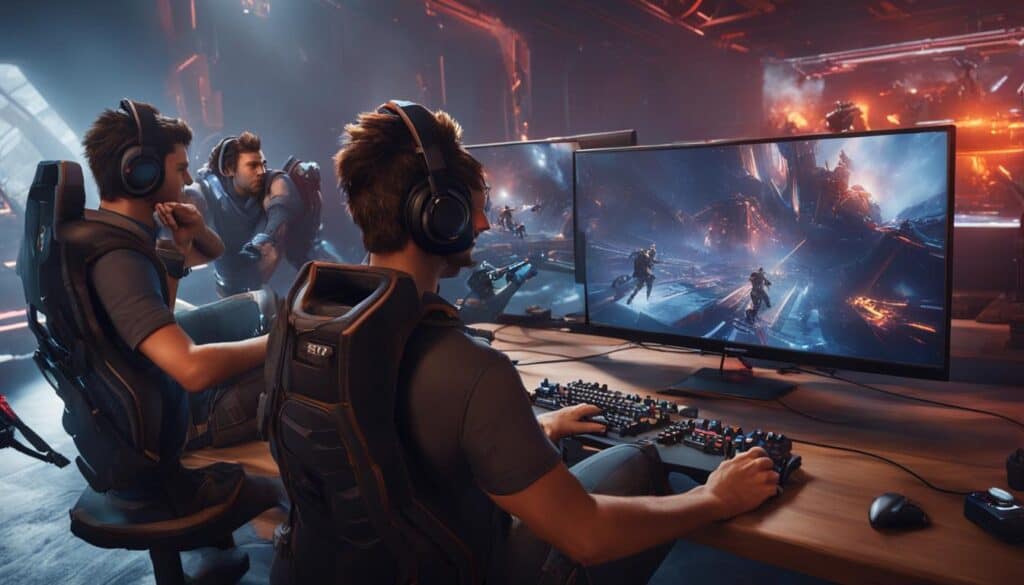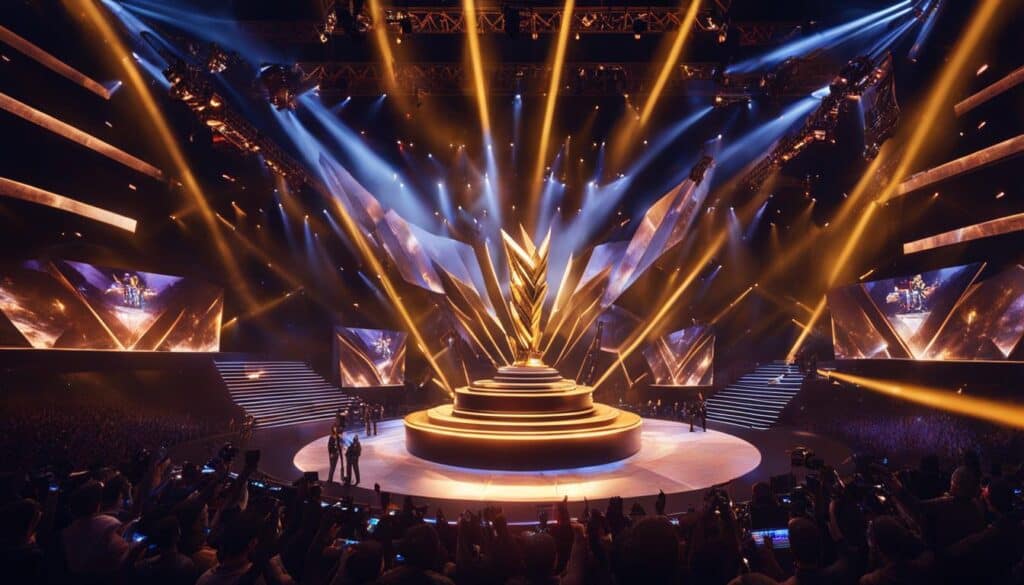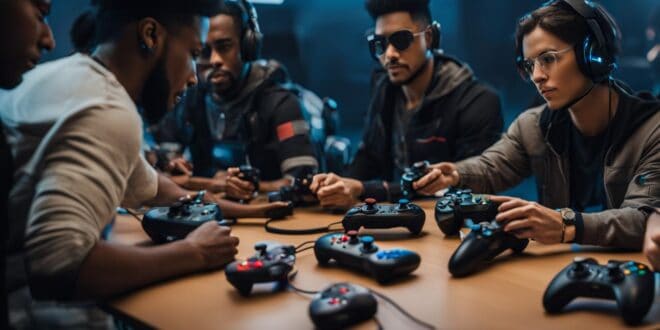The gaming industry is making significant progress in improving accessibility for all players, including those with disabilities. With advancements in technology and a focus on inclusivity, gaming is becoming more accessible than ever before. This article explores the efforts being made to create accessible video games and provide a more inclusive gaming experience for disabled players.
Key Takeaways:
- Gaming accessibility is improving, benefiting players with disabilities.
- Advancements in technology are driving greater inclusivity in gaming.
- Efforts are being made to create accessible video games for disabled players.
- The industry is recognizing the importance of accessibility through awards and initiatives.
- Positive gaming communities are fostering inclusivity and connections among players.
The Impact of Gamers Without Sight

Gamers without sight, like Ben (also known as Sightless Kombat or SK), are challenging the notion that video games are only for those who can see. These gamers rely on audio cues, in-game tweaks, and practice to navigate and play their favorite titles. They serve as advocates for accessibility and provide valuable insights to developers on how to make games more accessible to individuals with visual impairments.
Ben, known as Sightless Kombat, has become a prominent figure in the gaming community. Despite not being able to see the on-screen visuals, he has mastered games through careful coordination of audio cues and memorization of in-game sounds. By sharing his experiences and sharing tips and tricks, Ben paves the way for other visually impaired gamers to enjoy video games.
“Gaming has become an incredible medium for me to express myself and connect with others,” says Ben. “It’s not about winning or losing, but about the experiences and the sense of accomplishment.”
Advocating for Accessibility
Gamers like Ben play a crucial role in advocating for accessibility in the gaming industry. Their firsthand experiences highlight the challenges faced by visually impaired players and inspire developers to create more inclusive gaming experiences. By providing feedback and suggestions to game developers, these gamers contribute to the development of features such as audio descriptions, screen reader compatibility, and customizable interfaces.
The dedication and skill exhibited by gamers without sight bring attention to the importance of accessibility in gaming. Through their passion and perseverance, they break barriers and demonstrate that video games can be enjoyed by individuals with diverse abilities. As the industry continues to embrace inclusivity, the experiences and insights of gamers without sight will play a vital role in shaping the future of accessible gaming.
The Role of Accessibility Designers

Accessibility designers, such as Cari Watterton from Rebellion Developments, are at the forefront of making games more accessible to all players. These individuals play a crucial role in ensuring that video games cater to a wide range of abilities, from motor impairments to cognitive challenges.
One misconception about implementing accessibility features is that it requires significant resources. However, designers like Watterton are dispelling this notion by showing that even small changes can have a significant impact on players’ experiences. They work closely with developers to create features that improve accessibility without compromising the overall gaming experience.
Rebellion Developments, the studio where Cari Watterton works, is known for its commitment to accessibility. The company actively seeks input from players with disabilities and collaborates with accessibility consultants to identify and address potential barriers. By involving disabled gamers in the development process, Rebellion Developments ensures that their games are genuinely inclusive and accessible to a wide audience.
Creating an Inclusive Future
The work of accessibility designers like Cari Watterton is paving the way for a more inclusive future in the gaming industry. By championing accessibility, they are pushing the boundaries of what is possible and showing that games can be enjoyed by everyone, regardless of their abilities.
Inconsistent Accessibility Practices: Addressing the Gap

One of the challenges in gaming accessibility lies in the inconsistent implementation of accessibility features across different areas of a game. This can create frustration and barriers for players with disabilities who rely on these features to fully engage with the game. For example, menu narration and navigation assist should go hand in hand, but often one is missing, making it difficult for players to navigate the menu independently.
Developers need to address these inconsistencies and ensure that accessibility features are implemented consistently throughout a game. This includes providing options for different types of disabilities, such as customizable controls, visual cues for audio information, and adjustable difficulty levels. By prioritizing consistency in accessibility design, developers can ensure that all players, regardless of their abilities, have an equal and enjoyable gaming experience.
Menu Narration and Navigation Assist: A Seamless Experience
Menu narration and navigation assist are two essential accessibility features that should work together seamlessly to provide an inclusive gaming experience. Menu narration involves providing audio descriptions of the menus, options, and settings, allowing players with visual impairments to navigate the menu independently. On the other hand, navigation assist helps players with motor impairments by providing assistance in navigating the menu using alternative input methods, such as keyboard shortcuts or gamepad controls.
“As an accessibility designer, my goal is to ensure that players with disabilities can navigate the game menus effortlessly,” says Cari Watterton from Rebellion Developments. “Menu narration and navigation assist should complement each other, allowing players to fully engage with the game and access all its features.”
By implementing consistent menu narration and navigation assist throughout a game, developers can create a more inclusive and user-friendly experience for all players. This not only benefits players with disabilities but also enhances the overall gaming experience by providing intuitive and accessible menu navigation for everyone.
The Impact of Accessibility Initiatives in Gaming

The gaming industry is increasingly recognizing the importance of accessibility, with initiatives and advancements that aim to make gaming more inclusive for all players. One significant milestone in this journey is the inclusion of an accessibility category at the annual Game Awards. This recognition highlights the industry’s commitment to celebrating and promoting games that prioritize accessibility and provide a better gaming experience for disabled players.
A notable example of a company leading the way in accessibility efforts is Electronic Arts. They have taken steps to promote accessible game development by opening up their development tools. This move allows developers to create games with a focus on accessibility and encourages the industry as a whole to prioritize inclusivity. By providing resources and support, Electronic Arts is helping to pave the way for accessible gaming experiences.
Another important development in accessibility is the release of adaptive controllers. One such controller is Sony’s adaptive controller, designed specifically for disabled gamers. These controllers feature customizable inputs and options to accommodate a wide range of abilities, making gaming more accessible and enjoyable for players who may have physical limitations. The availability of adaptive controllers is a significant step towards ensuring that individuals with disabilities can fully participate in the gaming community.
Recognizing Achievements and Promoting Inclusivity
The Game Awards’ accessibility category, the efforts of companies like Electronic Arts, and the development of adaptive controllers are all significant achievements that contribute to a more inclusive gaming landscape. These initiatives not only recognize the importance of accessibility but also drive the industry to continually improve and prioritize the needs of disabled players. By celebrating and promoting accessibility in gaming, we can create a future where gaming is truly accessible to all.
Reviewing Accessibility in Popular Games
When it comes to creating inclusive gaming experiences, it’s crucial to assess the accessibility features of popular games. Review sites such as Game Accessibility Nexus and Can I Play That? are valuable resources that analyze games based on their assistance features. These sites provide detailed reviews that highlight the strengths and weaknesses of a game’s accessibility options, shedding light on areas where improvements can be made.
Game Accessibility Nexus goes beyond a conventional review by offering a comprehensive breakdown of a game’s accessibility settings, including visual, auditory, and cognitive features. Their reviews provide valuable insights into the level of accessibility a game offers and cater to a variety of disabilities. Can I Play That? focuses on exploring the accessibility of games from the perspective of disabled gamers, providing a firsthand look at the challenges and benefits of each title.
These review sites not only serve as a guide for disabled gamers but also provide feedback to developers on how to make their games more accessible. By highlighting areas where popular releases are lacking in terms of accessibility, these reviews contribute to raising awareness about the importance of creating inclusive gaming experiences. Ultimately, they play a vital role in driving the industry toward greater accessibility and inclusivity for all players.
The Importance of Accessibility Reviews
Accessibility reviews serve as a means to advocate for improved accessibility standards within the gaming industry. By examining popular games based on their assistance features, these reviews emphasize the significance of including accessibility options in game development. They also help developers gain a better understanding of the needs and challenges faced by disabled gamers, making it easier to implement changes that enhance the gaming experience for all players.
Furthermore, accessibility reviews contribute to a more informed gaming community. They empower players, both disabled and nondisabled, to make informed choices about the games they play. By providing ratings and detailed breakdowns of accessibility features, these reviews enable individuals to find games that suit their specific needs and preferences.
In conclusion, review sites like Game Accessibility Nexus and Can I Play That? play a crucial role in promoting accessibility and inclusivity within the gaming industry. By analyzing games based on their assistance features, these sites provide valuable feedback to developers and empower players to make informed choices. Moving forward, it is important for both developers and players to continue supporting and utilizing these resources to drive positive change and create a more inclusive gaming landscape.
The Impact of Community Building
The positive impact of community building in gaming cannot be understated. The formation of inclusive and supportive gaming communities has played a crucial role in breaking down negative stereotypes and fostering a sense of belonging among players. By creating games that encourage human interaction and provide opportunities for players to connect with one another, the gaming industry is paving the way for more positive gaming experiences.
Face-to-face interactions within gaming communities allow players to build relationships and develop a sense of camaraderie. Whether it’s joining a guild in an MMO or participating in local gaming meetups, these interactions provide a platform for individuals to share their love for games and create lasting connections. The power of these connections extends beyond the virtual world and can often lead to friendships that transcend gaming.
Moreover, the ability to shape their own stories within a game further enhances the positive gaming experience for players. Whether they are participating in cooperative gameplay or engaging in competitive multiplayer matches, the sense of agency and personal expression within the gaming world allows individuals to connect on a deeper level. This sense of empowerment and belonging fosters a welcoming environment that encourages players to embrace their individuality and be more inclusive of others.
Creating a welcoming environment:
- Encouraging collaboration and teamwork in multiplayer games
- Implementing chat moderation and fostering positive communication
- Promoting diversity and representation in game characters and narratives
- Organizing gaming events and tournaments that celebrate inclusivity
By focusing on community building and human interaction, the gaming industry is working towards breaking stigmatization and creating a more inclusive gaming culture. Through positive gaming communities, players can find a sense of belonging, form meaningful connections, and contribute to a more welcoming and diverse gaming landscape.
The Unique Ability of Games to Build Connections
Games have a remarkable power to build deep bonds and form connections among gamers. Whether it’s through cooperative gameplay, shared experiences, or online communities, gaming provides a platform for individuals to connect with others who share their passion.
One of the ways games foster connections is through the immersive and engaging nature of longer, service-driven games. These games often require significant time investment, allowing players to embark on epic journeys together. As they navigate challenges, conquer quests, and unlock achievements, players form deep bonds and create lasting memories. The shared experiences within these games provide a common ground for individuals to connect on a deeper level.
Gaming platforms also play a crucial role in forging connections. Online multiplayer games enable players to come together from different parts of the world, transcending geographical boundaries. They provide a space for individuals to interact, collaborate, and build relationships based on a shared interest in gaming. These platforms allow players to communicate through voice chats, text messages, or even video calls, fostering a sense of community and camaraderie.
Quotes:
“Gaming has given me the opportunity to meet people from all walks of life and form connections I never thought possible. It’s amazing how a common interest in games can bring people together.” – Sarah, avid gamer
“The gaming community is like a second family to me. Through online multiplayer games, I’ve made lifelong friends who understand and accept me for who I am. It’s a place where I can truly be myself.” – Jonathan, passionate gamer
The unique ability of games to build connections extends beyond the virtual world. Gaming communities often organize meet-ups, conventions, and tournaments where gamers can come together in person. These events provide an opportunity for individuals to strengthen their connections, make new friends, and share their love for games face-to-face. The social aspect of gaming helps break stigmas and stereotypes surrounding gamers, promoting inclusivity and acceptance.
Fostering Inclusive Gaming Communities
Inclusivity is a key aspect of creating positive gaming communities. Game developers have recognized the importance of inclusivity and are actively working towards creating multiplayer games that cater to a wider audience. By moving beyond the traditional focus on violent shooters and introducing different genres and gameplay styles, developers are providing opportunities for players to work together towards common goals instead of focusing solely on competition.
Multiplayer games that foster inclusivity encourage collaboration, cooperation, and teamwork. They create an environment where players can express themselves both individually and as a group, ensuring that everyone feels welcome and included. This approach not only expands the player base but also promotes a sense of belonging and acceptance within the gaming community.
By embracing inclusivity in games, developers are opening up new avenues for individuals who may have felt excluded in the past. These multiplayer games provide a platform for people of all backgrounds and abilities to come together, share their love for gaming, and form connections. The power of inclusive gaming communities lies in their ability to break free from negative stereotypes and stigmatization, creating spaces where individuals can be themselves and find support and camaraderie.
As the gaming industry continues to prioritize inclusivity, we can expect to see an even greater emphasis on creating multiplayer games that foster a sense of belonging and inclusiveness. By providing opportunities for players to join forces, work towards common goals, and form meaningful connections, these games will further enhance the positive impact gaming has on individuals and communities.
The Power of Gaming Communities
Gaming communities play a pivotal role in creating inclusive and supportive environments within the gaming industry. These communities break away from stigmatizations and stereotypes and promote a sense of belonging for gamers of all backgrounds and abilities. By encouraging players to form connections and interact with each other, gaming becomes a platform where everyone can express themselves freely and authentically.
Within these inclusive communities, individuals find solace in shared experiences and common interests. They can discuss and celebrate their favorite games, exchange tips and strategies, and even form lasting friendships. The power of gaming communities lies in their ability to foster positive interactions and connections, breaking down barriers and creating a sense of unity.
As gamers come together, they bring different perspectives, skills, and stories, enriching the overall gaming experience. In these communities, players have the opportunity to learn from one another, collaborate, and support each other’s growth. The inclusive nature of gaming communities fosters an environment where individuals feel empowered to be themselves, without fear of judgment or exclusion.
Fostering a Positive Environment
Inclusive and supportive gaming communities actively work towards creating a positive environment for all members. They establish and enforce community guidelines that promote respect, empathy, and diversity. By setting these standards, communities can ensure that everyone feels safe and valued, regardless of their gender, race, sexual orientation, or abilities.
“Gaming communities are like digital families, where everyone has a place and a voice.”
When gamers join supportive communities, they gain access to a wealth of knowledge and support. Whether it’s through forums, online groups, or social media platforms, these communities provide a space for individuals to ask questions, seek advice, and receive encouragement. This open exchange of information fosters a culture of learning and growth, benefiting both experienced and new gamers alike.
A Platform for Positive Change
Gaming communities have the power to drive positive change within the industry. By voicing concerns and advocating for inclusivity, gamers can influence game development, accessibility features, and representation within games. The collective voice of the community has the potential to shape the future of gaming, making it more diverse and accessible for all players.
- Encouraging discussions and feedback: Gaming communities provide a platform for individuals to voice their opinions and offer constructive feedback to developers. Through these discussions, developers can gain valuable insights and make improvements that benefit the entire gaming community.
- Advocating for accessibility: Inclusive communities highlight the importance of accessibility features in games and advocate for their implementation. By showcasing the impact of these features on players with disabilities, communities can push the industry towards creating more accessible gaming experiences.
- Promoting representation: Through their discussions and conversations, gaming communities can raise awareness about the need for representation within games. By advocating for diverse characters and storylines, they contribute to a more inclusive and representative gaming landscape.
The power of gaming communities is undeniable. By fostering inclusivity, support, and positive interactions, these communities create a space where individuals can thrive and connect with others who share their passion for gaming. Together, gamers have the ability to break down stigmas, challenge stereotypes, and shape the future of the gaming industry for the better.
The Future of Gaming Accessibility
The future of gaming accessibility is promising, as the industry continues to prioritize inclusivity and work towards providing a more accessible gaming experience for a wider audience. With advancements in technology and a growing awareness of the importance of accessibility, games are being developed with a focus on catering to the needs of players with disabilities.
Accessibility consultants and players with disabilities are playing a crucial role in shaping the future of gaming accessibility. Their valuable insights and feedback contribute to the development of features that enhance the gaming experience for individuals with different abilities. By involving these experts in the design process, developers can ensure that games are accessible from the ground up.
As the gaming industry moves forward, we can expect to see more innovative solutions that address specific accessibility challenges. From improved visual and auditory cues to customizable control options, games will continue to evolve to accommodate a diverse range of players. This will create opportunities for individuals who may have previously faced barriers to fully participate in the gaming community.
The future of gaming accessibility lies in the commitment of developers and industry professionals to prioritize inclusivity. By harnessing the power of technology and embracing the insights of players with disabilities, the gaming industry can ensure that games are not only entertaining but also accessible to a wider audience. With continued efforts, gaming will become a more inclusive and enjoyable experience for players of all abilities.
Conclusion
In conclusion, the gaming industry has made significant advancements in gaming accessibility. Through the efforts of accessibility designers, the recognition of achievements, and the power of gaming communities, gaming has become more inclusive and enjoyable for all players. However, there is still work to be done to ensure that individuals with disabilities have equal access to gaming.
The future of gaming accessibility looks promising. With continued prioritization and advocacy for accessibility, games will become more accessible to a wider audience. Technology will continue to play a crucial role in improving accessibility features, making gaming a more inclusive experience for all players.
It is important for the industry to recognize the importance of gaming accessibility and continue to push for advancements. By working together, developers, players, and accessibility professionals can ensure that gaming is accessible to everyone, regardless of their abilities. Through these collective efforts, the gaming community can create a future where all players can fully participate and enjoy the immersive world of gaming.
FAQ
How are video games becoming more accessible?
The gaming industry is making advancements in technology and focusing on inclusivity to make games more accessible for all players, including those with disabilities.
How do gamers without sight play video games?
Gamers without sight rely on audio cues, in-game tweaks, and practice to navigate and play their favorite titles. They provide insights to developers on how to make games more accessible to individuals with visual impairments.
What role do accessibility designers play?
Accessibility designers, such as Cari Watterton from Rebellion Developments, create features that cater to a wide range of abilities. They dispel the misconception that implementing accessibility features is costly and show that even small changes can have a significant impact on players’ experiences.
What is a common issue in gaming accessibility?
One common issue is the inconsistency of accessibility features across different areas of a game, such as menu narration and navigation assist. Developers need to address these inconsistencies and ensure that accessibility features are implemented consistently throughout a game.
How is the gaming industry recognizing achievements in accessibility?
The Game Awards now includes a category dedicated to accessibility, and companies like Electronic Arts are opening up their development tools to promote accessible game development. Sony has also released an adaptive controller specifically designed for disabled gamers.
Are there review sites that analyze games based on their accessibility features?
Yes, review sites like Game Accessibility Nexus and Can I Play That? analyze games based on their accessibility features. These reviews provide valuable feedback to developers and help raise awareness about the importance of creating inclusive gaming experiences.
What is the impact of community building in gaming?
Community building in gaming promotes positive behavior and inclusivity by encouraging players to form connections and interact with each other. It breaks negative stereotypes about gamers and fosters real-life connections.
How do games build connections among players?
Games that require significant time investment can lead to deep bonds and intimate connections among gamers. Gaming platforms provide a space for individuals to come together, share their love for games, and create meaningful connections.
How can gaming communities be more inclusive?
Game developers are encouraged to create multiplayer games in genres beyond violent shooters, where players can work together toward common goals instead of focusing solely on competition. By introducing different ways to interact and joint objectives, games become more accessible to a wider audience.
What is the power of gaming communities?
Gaming communities create inclusive and supportive environments, allowing for the expression of individuality and fostering positive interactions among gamers of all backgrounds.
What does the future of gaming accessibility look like?
As more developers prioritize inclusivity and work with accessibility consultants and players with disabilities, games will become more accessible to a wider audience. The gaming industry has the potential to positively impact a larger group of individuals than most people realize, making it important to continue pushing for accessibility.
 Online Gaming Circuit
Online Gaming Circuit




